Back to Journals » Open Access Journal of Sports Medicine » Volume 9
The relationship of wearing a wetsuit in long-distance open-water swimming with sex, age, calendar year, performance, and nationality – crossing the “Strait of Gibraltar”
Authors Nikolaidis PT , Sousa CV , Knechtle B
Received 30 November 2017
Accepted for publication 11 January 2018
Published 21 February 2018 Volume 2018:9 Pages 27—36
DOI https://doi.org/10.2147/OAJSM.S158502
Checked for plagiarism Yes
Review by Single anonymous peer review
Peer reviewer comments 4
Editor who approved publication: Prof. Dr. Andreas Imhoff
Pantelis Theodoros Nikolaidis,1 Caio Victor Sousa,2 Beat Knechtle3,4
1Exercise Physiology Laboratory, Nikaia, Greece; 2Graduate Program in Physical Education, Catholic University of Brasília, Brasília, Brazil; 3Medbase St. Gallen Am Vadianplatz, St. Gallen, Switzerland; 4Institute of Primary Care, University of Zurich, Zurich, Switzerland
Aim: The aim of the present study was to investigate the relationship of wearing a wetsuit with sex, age group, nationality, calendar year, and performance in crossing the “Strait of Gibraltar”(14.3 km).
Materials and methods: A sample of 1,130 open-water (females, n=180, age 35.9±11.9 years; males, n=950, age 40.0±10.2 years) ultra-distance swimmers crossing the “Strait of Gibraltar” since 1950 was analyzed.
Results: Male, older, and Spanish swimmers used wetsuits more often than female, younger, and athletes of other nationalities, respectively, and the use of the wetsuit has increased during the past three decades. Swimmers with wetsuits were faster than those without. Male athletes aged 30–34 years were faster than athletes >60 years. Female athletes were younger than male athletes, and swimmers with wetsuits were older than those without. The Spanish were faster than the American swimmers and athletes from other nationalities, and the American swimmers were the oldest.
Conclusion: In summary, swimmers were faster when using a wetsuit, and local Spanish swimmers were the fastest and also used wetsuits most frequently. Male and older swimmers used wetsuits more often than other swimmers, and the use of wetsuits has increased in the last three decades.
Keywords: aging, master athlete, endurance, water sport, physiology, gender
Introduction
Open-water ultra-distance swimming, that is, covering a distance longer than the Olympic discipline of 10 km whose world record corresponds roughly to the world record of marathon running, is increasing in popularity. For example, in the “English Channel Swim”, the number of annual participants has increased exponentially in the past decades.1 Open-water ultra-distance swimmers have to swim in their swimsuit and are not allowed to wear a wetsuit to protect against the cold. The first studies examining the effects of a wetsuit on swimmers and divers were conducted in the 1980s.2–4 A wetsuit made of neoprene traps a thin layer of water which gets warmed by the body resulting in the insulation of the body similar to what body fat does.2 Compared with a swimsuit, a wetsuit has been shown to enhance swimming performance by 3%–10%.5 Wearing a wetsuit might give an advantage of speed in open-water ultra-distance swimming.3,6 When open-water swimming performances at the 26.4 km “Marathon Swim in Lake Zurich” in Lake Zurich, Switzerland, and the 3.8 km “Lake Ontario Swim Team-Race” in Lake Ontario, Canada, were investigated where swimmers can compete with or without a wetsuit, wearing a wetsuit increased swimming speed for both females and males but the benefit of the use of wetsuits seemed to depend on additional factors (i.e., race distance). Females seemed to benefit more from wearing wetsuits than males in longer open-water ultra-distance swimming races.7 In that study, only the sex of the athletes swimming with or without a wetsuit was compared. However, other aspects such as age or nationality of the athletes were not considered.
In the “Triple Crown of Open Water Swimming” with the “Catalina Channel Swim”,1 the “Manhattan Island Marathon Swim”,8 and the “English Channel Swim”,9 swimmers are restricted to wearing only a standard swim costume. Such a standard swimsuit for both sexes must be of a material not offering thermal protection or buoyancy and must be sleeveless and legless. Sleeveless means that the suit must not extend beyond the end of the shoulder onto the upper arm and legless means the suit must not extend onto the upper leg below the level of the crotch (https://www.channelswimmingassociation.com/).
Although generally open-water ultra-distance swimmers are not allowed to wear a wetsuit, in some events, categories are offered that allow wetsuits. Therefore, more detailed studies would be of interest, such as the trend of wearing wetsuits over the years, whether younger or older swimmers are wearing wetsuits, and whether athletes of certain nationalities would rather use wetsuits than would swimmers of other nationalities. Some results, such as wetsuit performance, would be of great practical value for open-water swimmers and professionals (e.g., coaches and fitness trainers), whereas other results, such as the use of wetsuit by sex, nationality, and age-groups, would be of great value to wetsuit manufacturers in order to target their design and marketing with specific demographic data.
Considering the aspect of wearing a wetsuit and the effect on swimming performance, different problems arise, such as wearing a wetsuit might be associated with swimming distance, water temperature, competitive level, prestige and the use of other modalities of thermal protection.2,3,5 A further problem is that events of the “Triple Crown of Open Water Swimming” do not allow the wearing of wetsuits. There is, however, the “Strait of Gibraltar” offering the opportunity to swimmers to cross the Strait of Gibraltar with or without a wetsuit. Since not all open-water ultra-distance swimming events allow the use of wetsuits, we selected the traditional European race “Strait of Gibraltar” to perform such an investigation. Therefore, the aim of the present study was to examine the relationship of wearing a wetsuit with sex, age, calendar year, nationality, and swim performance. We hypothesized that wearing a wetsuit improves performance, has increased across the years, is more common in males and older swimmers, and might be associated with nationality.
Materials and methods
Ethics approval
All procedures used in the study were approved by the Institutional Review Board of Kanton St. Gallen, Switzerland, with a waiver of the requirement for informed consent of the participants given the fact that the study involved the analysis of publicly available data (www.acneg.com).
Methodology
The Strait of Gibraltar is a narrow strait connecting the Atlantic Ocean to the Mediterranean Sea and separating Gibraltar and the Peninsular Spain in Europe from Morocco and Ceuta (Spain) in Africa. Europe and Africa are separated by 7.7 nautical miles (14.3 km) of ocean at the strait’s narrowest point. The ACNEG (AsociaciónCruce a NadoEstrecho de Gibraltar) records every swim from Spain to the North African coast. The starting place for the crossing is located in Tarifa. The crossing starts after sunrise from the support boat located at Tarifa Island and the swimmer must touch the rocks. Then, the swimmer crosses the Strait of Gibraltar and the crossing must end before sunset at a natural point on the North African coast in Morocco or Spain. Following ACNEG, swimmers can cross the Strait of Gibraltar with or without a wetsuit and are recorded in two separate lists. Swim times were obtained from the official website www.acneg.com. Only solo swims were included in the analysis.
From the initial sample (n=1,135; with and without wetsuit), five swimmers with extreme (differed >4 SD from mean) scores were excluded from further analysis resulting in a final sample of 1,130 swimmers. Participants were classified into 10 age groups of 5-year intervals: <20, 20–24, 25–29, 30–34, 35–39, 40–44, 45–49, 50–54, 55–59, and >59 years. We analyzed four nationality groups (i.e., those with more than 100 swimmers and at least 20 participants of each sex): Spanish (n=457), American (n=123), British (n=111), and “Other” (n=439) swimmers. Details for the “Other” nationalities are presented in Tables S1 and S2. Calendar year groups were classified into four groups: 1950–1989 (n=38), 1990–1999 (n=28), 2000–2009 (n=303), and 2010–2016 (n=761).
Statistical analysis
All statistical analyses were performed by the statistical package IBM SPSS v.20.0 (SPSS, Chicago, IL, USA). Kolmogorov–Smirnov Test and visual inspection of normal Q–Q plots were used to test normality of data. Data were presented as mean±SD. We examined the association of sex and age group with wetsuit using chi-square (c2) and used Cramer’s phi (ϕC) to evaluate the magnitude of association. A two-way analysis of variance (ANOVA) examined the main effect and the interaction of sex, wetsuit, age group, nationality, and calendar year on swimming time. Bonferroni post hoc multiple comparison test showed the differences among groups. The magnitude of differences in the ANOVA was evaluated using eta squared (η2) as trivial (η2<0.01), minor (0.01≤η2<0.06), moderate (0.06≤η2<0.14), and great (η2≥0.14).10 To investigate swimming time differences by sex, age group, nationality, calendar, and wetsuit, we used a mixed-effects regression model with swimmers as random variable, whereas sex, age group, nationality, calendar year, and wetsuit were assigned as fixed variables. In addition, we examined interaction effects between these fixed variables. Akaike information criterion was used to select the final model. Alpha level was set at 0.05.
Results
Variation of the use of wetsuit by sex, age groups, calendar year, and nationality
The rate of wetsuit use was 50.0%. A sex×wetsuit association was observed (c2=11.657, p=0.001, Cramer’s ϕ=0.102), where more males (52.2%) than females (38.3%) used a wetsuit. In females (c2=20.448, p=0.015, Cramer’s ϕ=0.338) and males (c2=22.874, p=0.006, Cramer’s ϕ=0.156), a wetsuit×age group association was shown, where athletes in older age groups used a wetsuit more often than athletes in younger age groups (Figure 1). A wetsuit×calendar year association was found among females (c2=19.688, p<0.001, Cramer’s ϕ=0.331) and males (c2=62.510, p<0.001, Cramer’s ϕ=0.257), in which the use of a wetsuit increased during the last three decades (Figure 2). In addition, a wetsuit×nationality association was observed, where Spanish females (c2=40.269, p<0.001, Cramer’s ϕ=0.473) and males (c2=206.967, p<0.001, Cramer’s ϕ=0.467) used more wetsuits than Americans, British, and other nationalities (Figure 3).
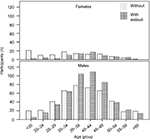  | Figure 1 Use of wetsuit by age group. Note: The number of participants without or with wetsuit by 5-year age groups is presented separately for females (up) and males (down). |
Effect of sex, age group, and wetsuit on swimming time
A trivial effect of sex on swimming time was observed (p=0.044, η2=0.004), in which males swam faster than females (4:33±0:56 vs 4:42±0:54 h:min, respectively; Figure 4). The findings of the multivariate regression models for the swimming time by sex and wetsuit can be seen in Table 1. Overall, there was neither an effect of wearing a wetsuit (p=0.120, η2=0.002) nor a sex×wetsuit interaction on swimming time (p=0.167, η2=0.002). In females, there was neither an effect of wearing a wetsuit (p=0.163, η2=0.012), age group (p=0.202, η2=0.072), nor a wetsuit×age group interaction on swimming time (p=0.061, η2=0.087). Among males, a trivial effect of wearing a wetsuit on swimming time was shown (p=0.035, η2=0.005), where swimmers wearing a wetsuit were faster than those without (4:26±0:50 vs 4:39±1:00 h:min, respectively). In addition, a minor effect of age group on swimming time was found (p=0.036, η2=0.019), where athletes in the age group 30–34 years were faster than athletes in the age group >60 years (4:26±0:52 vs 5:05±1:03 h:min, respectively). No wetsuit×age group interaction on swimming time was observed (p=0.411, η2=0.010). The results of the multivariate regression models for the swimming time by age group and wetsuit in females and males are shown in Table 2.
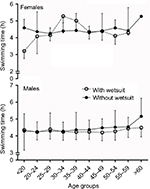  | Figure 4 Swimming time without (solid line) and with wetsuit (dashed line) by age group. Notes: Race time by 5-year age group for females (upper) and males (lower). Error bars represent SD. |
Effects of sex and wetsuit on age
A minor effect of sex on age was shown (p<0.001, η2=0.013), where female athletes were younger than male (35.9±11.9 vs 40.0±10.2 years, respectively). Moreover, a minor effect of wearing a wetsuit on age was found (p<0.001, η2=0.019), in which swimmers wearing a wetsuit were older than those not wearing a wetsuit (40.5±9.1 vs 38.1±11.7 years, respectively).
Effect of nationality on swimming time and age
For females, no difference in swimming time among nationalities was observed (p=0.829, η2=0.005), wherein the times were 4:39±0:55, 4:45±0:51, 4:34±0:50, and 4:45±0:56 h:min for Spanish, American, British, and other swimmers, respectively (Figure 5, Table 3). Spanish (38.0±10.1 years), American (38.3±12.3 years), British (37.9±9.0 years), and other females (33.4±12.8 years) did not differ in age (p=0.092, η2=0.036). For the males, there was a minor effect of nationality on swimming time (p<0.001, η2=0.026), where the Spanish (4:23±0:52 h:min) were faster than the American swimmers (4:44±0:48 h:min) and swimmers from other nationalities (4:40±1:01 h:min), but not the British (4:38±0:49 h:min). A minor effect of nationality on age was observed (p<0.001, η2=0.044), where Americans (46.5±11.7 years) were older than the Spanish (39.1±8.6 years), British (38.6±10.3 years), and other swimmers (39.8±10.9 years).
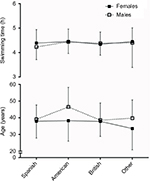  | Figure 5 Swimming time (upper) and age (lower) by nationality in females (solid line) and males (dashed line). Note: Error bars represent SD. |
Effect of calendar year on swimming time and age
For females, a moderate difference in swimming time between calendar years was observed (p=0.022, η2=0.053), but the post hoc analysis did not reveal any particular differences (Figure 6, Table 4). The age of female swimmers increased greatly across calendar years (p<0.001, η2=0.249). Male swimming time decreased moderately across calendar years (p<0.001, η2=0.084). Also, the age of male swimmers increased (with small magnitude) across calendar years (p<0.001, η2=0.038).
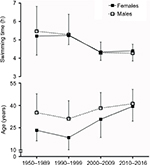  | Figure 6 Swimming time (upper) and age (lower) by calendar year in females (solid line) and males (dashed line). Note: Error bars represent SD. |
Discussion
The main findings of the present study were that 1) male, older, and Spanish swimmers used a wetsuit more frequently than female, younger swimmers, and swimmers from other nationalities, respectively; 2) the use of a wetsuit increased during the last three decades; 3) a trivial difference between the sexes in swimming time occurred in which males swam faster than females; 4) swimmers wearing a wetsuit were faster than those swimmers not wearing a wetsuit; 5) female athletes were younger than male athletes, and swimmers wearing a wetsuit were older than those swimmers without a wetsuit. Additional findings included: 6) male Spanish swimmers were faster than male American swimmers and male swimmers from other nationalities, but not male British swimmers and 7) American males were the oldest to perform the crossing. These findings confirmed our hypotheses about the trends in wearing a wetsuit with regards to performance, sex, age, calendar year, and nationality.
The use of wetsuits in crossing the Strait of Gibraltar
Regarding the use of wetsuits in crossing the Strait of Gibraltar, we found that the number of swimmers using a wetsuit has increased in the last three decades. This result agrees with a previous study of the 26.4 km “Marathon Swim in Lake Zurich” in Lake Zurich, Switzerland, and the 3.8 km “Lake Ontario Swim Team-Race” in Lake Ontario, Canada, where the number of swimmers using a wetsuit increased during the examined period (2002–2012).7 Furthermore, males and older swimmers in the present study used a wetsuit more often than females and younger swimmers. A potential explanation for the increase in the use of wetsuits is the fact that long-distance triathletes competing in Ironman triathlons and longer races have started to use wetsuits in the past few decades2,11 and most likely, open-water swimmers also have started to use wetsuits at that time. Furthermore, wetsuit production has greatly improved in last decades with the popularity of triathlons and open-water marathons, increasing the wetsuit’s technology but also decreasing the fabrication cost, making this equipment more accessible to swimmers.
Regarding the sex- and age-related differences in the use of wetsuit, the more frequent use of wetsuits among males and older finishers might be attributed to sex- and age-related differences in performance. In long-distance swimming events like the “Catalina Channel Swim”1 and the “Manhattan Island Marathon Swim”,8 females were faster than males. Moreover, younger swimmers were faster than older swimmers in the 3000 m open-water swim.12 It has been shown that wearing a wetsuit increased performance by increasing buoyancy and that leaner subjects benefit more from wearing a wetsuit than fatter subjects.3 Increased buoyancy reduces the energetic demands of maintaining the horizontal position, and this economy is invested in reinforcing propulsive actions.5 Also, the number of males finishers is approximately five times larger than females suggesting that females finishers are more “selected”, whereas there is more likely a larger range of swimming ability among the male swimmers compared with the female swimmers. Thus, our findings were in agreement with the suggestion that the slower the swimmer, the greater will be the expected effect of the wetsuit.5
However, the results of studies11,13,14 that examined the physiological mechanisms underpinning the use of wetsuit were not consistent and were conducted mostly amongst triathletes. For instance, in a small sample of triathletes swimming 750 m with a wetsuit, lower swimming cadence, lower heart rate, and lower lactate values were recorded than in swimming without a wetsuit.13 On the other hand, in another study on a small sample of triathletes, performance gains in wearing a wetsuit were attributable to gains in buoyancy and drag reduction rather than to physiological factors.11 Moreover, inferences should be drawn with caution from studies in triathletes to swimmers, as it has been suggested that wearing a wetsuit relates differently to stroke characteristics and performance among these two groups of athletes.15
The aspect of performance
Males were faster than females (i.e., a trivial difference in swimming times between the sexes), which was in agreement with the findings of recent studies on 3000 m open-water,12 freestyle,16 and breaststroke17 swimmers. This observation should be attributed to anthropometric and physiological sex differences.18 However, other studies have shown an opposite trend; females were faster than males in the “Catalina Channel Swim”1 and the “Manhattan Island Marathon Swim”8 but not in the “English Channel Swim”.9,19
A further result was that swimmers wearing a wetsuit were faster than those without a wetsuit. It is well known that the use of a wetsuit improves swimming time.20 It has been shown that the use of wetsuits improves performance more for inefficient swimmers with low buoyancy and low swimming speeds.6 Moreover, since the use of wetsuits increased swimming speed in the Strait of Gibraltar and more males used a wetsuit, the trivial sex difference was likely due to the elevated wetsuit use by males.
The aspect of age
Regarding the aspect of age, we found that swimming times decreased and the age of swimmers increased across calendar years. Although this result that performance improves with increasing age might seem contradictory, a recent study investigating the annual top 10 females and males competing at the Ironman World Championship “Ironman Hawaii” from 1983 to 2012 showed that the age of these triathletes increased over the last three decades while their performances improved.21
Further findings regarding age were that male swimmers aged 30–34 years were faster than swimmers >60 years, females were younger than males, and swimmers wearing a wetsuit were older than those swimmers not wearing a wetsuit. It was well known that younger swimmers were faster than older freestyle,16 breaststroke,17 and open-water swimmers.12 The use of wetsuits improves performance more for inefficient swimmers swimming at low speeds,6,22 and, therefore, especially older and weaker swimmers might benefit from wearing a wetsuit.
The aspect of nationality
Considering the aspect of nationality, we found that Spanish swimmers used a wetsuit more often than swimmers from other nationalities; male Spanish swimmers were faster than American swimmers and swimmers from other nationalities, but not British swimmers, and male American swimmers were the oldest. The higher use of wetsuits by Spanish swimmers might be explained by the fact that Spanish swimmers as local athletes compete more often in this event as has been shown for British swimmers crossing the English Channel.1 The discovery that Spanish swimmers were faster than other swimmers might also be explained by their vicinity to the Strait of Gibraltar. In the “English Channel Crossing”, local British swimmers were also among the top three swimmers.1
A limitation of the present study was the specific characteristics of the Strait of Gibraltar in terms of distance and environmental conditions (e.g., temperature), since these might influence performance and, consequently, the application of the results to other open-water races. Another limitation was the lack of information about whether the use of wetsuit was not permitted in the past, for example, it was observed that nobody used one before 1990s; however, this observation cannot definitely be attributed to preference or regulations. Participation in open-water swimming has increased during the last years,7,12 thus, the findings of the present study are of great practical value for researchers, wetsuit manufacturers, and swimming coaches working with recreational and competitive open-water swimmers. The present study focused on performance aspects of wearing wetsuit in an open-water swim. Considering the prevalence of hypothermia and afterdrop experienced by open-water swimmers,23,24 and the association of the wetsuit with gastrointestinal illness,25 future studies should focus on the health aspects of wearing wetsuit.
In summary, for athletes crossing the Strait of Gibraltar, swimmers were faster when using a wetsuit, and local Spanish swimmers were the fastest and also used wetsuits most frequently. Furthermore, males and older swimmers used wetsuits more than other swimmers, and the use of wetsuits has increased in the last six decades. Although the positive effect of wetsuit on performance was already known, a novel discovery was the relationship of wearing wetsuit with sex, age, calendar year, and nationality.
Acknowledgment
We thank Patricia Villiger for her help in the English language edit.
Disclosure
The authors report no conflicts of interest in this work.
References
Knechtle B, Rosemann T, Rüst CA. Participation and performance trends by nationality in the “English Channel Swim” from 1875 to 2013. BMC Sports Sc Med Rehabil. 2014;6(1):34. | ||
Parsons L, Day SJ. Do wet suits affect swimming speed? Br J Sports Med. 1986;20(3):129–131. | ||
Cordain L, Kopriva R. Wetsuits, body density and swimming performance. Br J Sports Med. 1991;25(1):31–33. | ||
Veicsteinas A, Rennie DW. Thermal insulation and shivering threshold in Greek sponge divers. J Appl Physiol Respir Environ Exerc Physiol. 1982;52(4):845–850. | ||
Chatard JC, Millet G. Effects of wetsuit use in swimming events. Practical recommendations. Sports Med. 1996;22(2):70–75. | ||
Chatard JC, Senegas X, Selles M, Dreanot P, Geyssant AA. Wet suit effect: a comparison between competitive swimmers and triathletes. Med Sci Sports Exerc. 1995;27(4):580–586. | ||
Ulsamer S, Rüst CA, Rosemann T, Lepers R, Knechtle B. Swimming performances in long distance open-water events with and without wetsuit. BMC Sports Sci Med Rehabil. 2014;6(1):20. | ||
Knechtle B, Rosemann T, Lepers R, Rüst CA. Women outperform men in ultradistance swimming: the Manhattan Island Marathon Swim from 1983 to 2013. Int J Sports Physiol Perform. 2014;9(6):913–924. | ||
Eichenberger E, Knechtle B, Knechtle P, RüSt CA, Rosemann T, Lepers R. Best performances by men and women open-water swimmers during the “English Channel Swim” from 1900 to 2010. J Sports Sci. 2012;30(12):1295–1301. | ||
Hopkins WG, Marshall SW, Batterham AM, Hanin J. Progressive statistics for studies in sports medicine and exercise science. Med Sci Sports Exerc. 2009;41(1):3–13. | ||
Tomikawa M, Nomura T. Relationships between swim performance, maximal oxygen uptake and peak power output when wearing a wetsuit. J Sci Med Sport. 2009;12(2):317–322. | ||
Knechtle B, Nikolaidis PT, Rosemann T, Rust CA. Performance trends in 3000 m open-water age group swimmers from 25 to 89 years competing in the FINA World Championships from 1992 to 2014. Res Sports Med. 2017;25(1):67–77. | ||
Delextrat A, Bernard T, Hausswirth C, Vercruyssen F, Brisswalter J. Effet du port de combinaison sur la dépense énergétique lors d’un enchainement natation-cyclisme [Effects of swimming with a wet suit on energy expenditure during subsequent cycling]. Can J Appl Physiol. 2003;28(3):356–369. French. | ||
Hutteau M, Bertucci W, Lodini A. Effect of using a complete wetsuit and a tri function on swimming speed and amplitude in triathlon. Sci Sports. 2007;22(1):60–62. | ||
Perrier D, Monteil KM. Wetsuits and performance: influence of technical abilities. J Human Movement Studies. 2001;41(3):191–207. | ||
Knechtle B, Nikolaidis PT, König S, Rosemann T, Rüst CA. Performance trends in master freestyle swimmers aged 25-89 years at the FINA World Championships from 1986 to 2014. Age (Dordr). 2016;38(1):18. | ||
Knechtle B, Nikolaidis PT, Rosemann T, Rust CA. Performance trends in age group breaststroke swimmers in the FINA World Championships 1986–2014. Chin J Physiol. 2016;59(5):247–259. | ||
Nikolaidis PT. Age- and sex-related differences in force-velocity characteristics of upper and lower limbs of competitive adolescent swimmers. J Hum Kinet. 2012;32:87–95. | ||
Fischer G, Knechtle B, Rüst CA, Rosemann T. Male swimmers cross the English Channel faster than female swimmers. Scand J Med Sci Sports. 2013;23(1):e48–e55. | ||
Chatard JC, Wilson B. Effect of fastskin suits on performance, drag, and energy cost of swimming. Med Sci Sports Exerc. 2008;40(6):1149–1154. | ||
Gallmann D, Knechtle B, Rüst CA, Rosemann T, Lepers R. Elite triathletes in “Ironman Hawaii” get older but faster. Age (Dordr). 2014;36(1):407–416. | ||
Tomikawa M, Shimoyama Y, Nomura T. Factors related to the advantageous effects of wearing a wetsuit during swimming at different submaximal velocity in triathletes. J Sci Med Sport. 2008;11(4):417–423. | ||
Nuckton TJ, Claman DM, Goldreich D, Wendt FC, Nuckton JG. Hypothermia and afterdrop, following open water swimming: The Alcatraz/San Francisco Swim study. Am J Emerg Med. 2000;18(6):703–707. | ||
Stjepanovic M, Nikolaidis PT, Knechtle B. Swimming three ice miles within fifteen hours. Chin J Physiol. 2017;60(4):197–206. | ||
Hall V, Taye A, Walsh B, et al. A large outbreak of gastrointestinal illness at an open-water swimming event in the River Thames, London. Epidemiol Infect. 2017;145(6):1246–1255. |
Supplementary materials
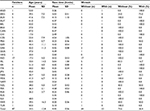  | Table S1 Finishers, age, race time, and wetsuit in the “Other” nationalities (females) |
  | Table S2 Finishers, age, race time, and wetsuit in the “Other” nationalities (males) |
 © 2018 The Author(s). This work is published and licensed by Dove Medical Press Limited. The full terms of this license are available at https://www.dovepress.com/terms.php and incorporate the Creative Commons Attribution - Non Commercial (unported, v3.0) License.
By accessing the work you hereby accept the Terms. Non-commercial uses of the work are permitted without any further permission from Dove Medical Press Limited, provided the work is properly attributed. For permission for commercial use of this work, please see paragraphs 4.2 and 5 of our Terms.
© 2018 The Author(s). This work is published and licensed by Dove Medical Press Limited. The full terms of this license are available at https://www.dovepress.com/terms.php and incorporate the Creative Commons Attribution - Non Commercial (unported, v3.0) License.
By accessing the work you hereby accept the Terms. Non-commercial uses of the work are permitted without any further permission from Dove Medical Press Limited, provided the work is properly attributed. For permission for commercial use of this work, please see paragraphs 4.2 and 5 of our Terms.






